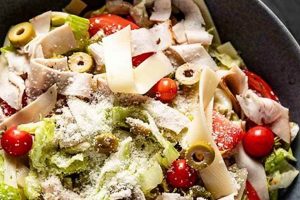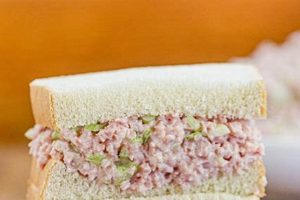A dish featuring thinly sliced vegetables, often served as a light meal or appetizer, exemplifies the culinary technique of “julienne.” Carrots, cucumbers, and bell peppers are common components, frequently combined with a vinaigrette or creamy dressing. Variations may incorporate protein like chicken or shrimp, or other ingredients such as nuts, seeds, or dried fruits.
The precise cutting technique involved offers both aesthetic and practical advantages. Uniformly slender pieces create an elegant presentation and ensure even cooking and marinating, resulting in a harmonious blend of flavors and textures. This method has a rich history, stemming from classic French cuisine, where precision and presentation are highly valued. Its enduring popularity reflects its versatility and adaptability to diverse culinary traditions.
Further exploration will delve into specific vegetable preparation methods, dressing options, and innovative combinations for creating a range of flavorful and visually appealing dishes that utilize this fundamental technique. Discussions of nutritional benefits and variations suited to different dietary needs will also be addressed.
Tips for Julienne Salad Preparation
Achieving optimal results when preparing dishes featuring thinly sliced vegetables requires attention to several key factors. The following tips offer guidance for maximizing flavor, texture, and presentation.
Tip 1: Knife Selection and Sharpening: A sharp knife with a smooth blade is essential for clean, consistent cuts. Dull knives can crush delicate vegetables, impacting both appearance and texture. Regular sharpening is recommended.
Tip 2: Consistent Vegetable Size: Aim for uniform slices, approximately 1/8 inch thick and 2-3 inches long. This ensures even cooking and marinating, enhancing the overall balance of the dish.
Tip 3: Vegetable Selection and Preparation: Choose fresh, firm vegetables. Proper washing and drying are crucial before cutting to prevent slippage and ensure clean cuts.
Tip 4: Mastering the Julienne Technique: Square off the vegetable before slicing into thin planks. Stack the planks and cut them lengthwise into thin strips. Practice improves speed and precision.
Tip 5: Dressing Selection and Application: The dressing complements the vegetables and enhances their flavors. Light vinaigrettes or creamy dressings work well. Add dressing just before serving to prevent the salad from becoming soggy.
Tip 6: Ingredient Combinations: Explore various vegetable combinations, incorporating contrasting colors and textures. Adding protein or other elements like nuts or dried fruits enhances nutritional value and flavor complexity.
Tip 7: Proper Storage: Store prepared vegetables separately from dressings to maintain crispness. Refrigerate promptly and consume within a few days for optimal freshness.
By following these guidelines, one can create visually appealing and flavorful dishes that showcase the versatility and elegance of this classic culinary technique.
This detailed guidance allows for a more nuanced understanding of the art of preparing dishes with finely sliced vegetables. The following section will provide concluding remarks and suggest avenues for further exploration.
1. Fresh, High-Quality Vegetables
The foundation of a successful julienne salad rests upon the selection of fresh, high-quality vegetables. Their inherent flavors and textures are showcased through the delicate julienne cut, making their quality paramount. Subpar produce can detract significantly from the final dish, impacting both taste and presentation.
- Flavor Enhancement:
Freshly harvested vegetables possess vibrant, pronounced flavors that contribute significantly to the overall taste profile of the salad. The thin julienne cut exposes more surface area, allowing the nuanced flavors to meld effectively with the dressing and other ingredients. Examples include the sweetness of a perfectly ripe bell pepper or the subtle earthiness of a fresh carrot.
- Textural Integrity:
Crisp, firm vegetables maintain their structure when cut into thin strips, providing a pleasing textural contrast against the dressing. Wilted or overripe produce results in a limp, unappetizing salad. The snap of a fresh cucumber or the satisfying crunch of a jicama are prime examples of desirable textural qualities.
- Visual Appeal:
Vibrant colors and unblemished surfaces enhance the presentation of a julienne salad. Fresh, high-quality vegetables possess a natural sheen and vibrant hues that contribute to an aesthetically pleasing dish. A mix of colorful bell peppers, carrots, and red cabbage creates a visually striking presentation.
- Nutritional Value:
Fresh vegetables offer optimal nutritional benefits, providing essential vitamins, minerals, and antioxidants. These nutrients are best preserved when vegetables are consumed soon after harvest. A salad composed of nutrient-rich vegetables like spinach, kale, and broccoli enhances the overall health benefits of the meal.
The emphasis on fresh, high-quality vegetables ensures a superior julienne salad. The interplay of flavor, texture, visual appeal, and nutritional value contributes to a more satisfying and healthful culinary experience.
2. Precise Julienne Cutting Technique
Precision in julienne cutting significantly influences the final quality of a julienne salad. Uniformity in size and shape affects not only the aesthetic presentation but also the texture and flavor development. Consistent size ensures even cooking or marinating, preventing some pieces from becoming overly softened while others remain too firm. This consistency contributes to a harmonious blend of textures and allows the flavors of the vegetables and dressing to meld evenly. For instance, uniformly cut carrots will absorb the marinade at the same rate, resulting in a balanced flavor profile throughout the salad.
Furthermore, the precise julienne cut maximizes surface area, allowing for greater interaction between the vegetables and the dressing. This increased surface area enhances flavor absorption and contributes to a more vibrant and well-integrated taste experience. Consider a salad with julienned cucumbers; the thin strips readily absorb the flavors of a vinaigrette, resulting in a refreshing and flavorful bite. Conversely, thicker, unevenly cut pieces might limit flavor penetration, leading to a less satisfying outcome.
Mastering the precise julienne technique is therefore crucial for achieving a visually appealing and flavorful julienne salad. It ensures consistent texture, enhances flavor development, and elevates the overall dining experience. While variations in the specific dimensions of the julienne cut exist, the underlying principle of uniformity remains essential for maximizing the potential of this culinary technique. This understanding allows for greater control over the final product, enabling the creation of salads that are both visually stunning and deliciously satisfying.
3. Balanced, Flavorful Dressing
A balanced, flavorful dressing is integral to a successful julienne salad recipe. It provides a unifying element, binding the individual vegetable components while enhancing their inherent flavors. The dressing should complement, not overpower, the delicate flavors of the fresh produce. An overly acidic vinaigrette, for example, can mask the subtle sweetness of julienned carrots or bell peppers, while a heavy, creamy dressing might overwhelm the refreshing crispness of cucumbers or jicama. A balanced dressing achieves harmony, allowing the individual flavors of the vegetables to shine through while contributing its own unique character.
The interplay between acidity, sweetness, saltiness, and other flavor components within the dressing is crucial. A classic vinaigrette, for instance, achieves balance through the careful proportioning of oil, vinegar, and seasonings. The oil provides a smooth texture and carries the flavors of the other ingredients, while the vinegar adds a refreshing tang. A touch of sweetness, perhaps from a drizzle of honey or a pinch of sugar, can further enhance the balance and complexity of the dressing. Adding herbs, spices, or other aromatics, such as minced garlic or shallots, introduces additional layers of flavor that complement the vegetables. For a creamy dressing, the balance might involve carefully adjusting the ratio of mayonnaise, yogurt, or sour cream with other ingredients like lemon juice, Dijon mustard, and herbs.
Achieving a balanced, flavorful dressing elevates the julienne salad from a simple collection of ingredients to a cohesive and satisfying dish. It enhances the sensory experience, providing a counterpoint to the textures and flavors of the vegetables. The practical significance of this understanding lies in the ability to create dressings tailored to specific vegetable combinations and personal preferences. Mastering this aspect of salad preparation allows for greater culinary creativity and ensures a consistently delicious and enjoyable result.
4. Complementary Ingredient Combinations
Ingredient combinations significantly influence the overall balance and complexity of a julienne salad recipe. Thoughtful selection of complementary ingredients elevates the salad beyond a simple sum of its parts, creating a harmonious blend of flavors, textures, and colors. The interplay of these elements contributes to a more satisfying and nuanced culinary experience.
- Textural Variety:
Incorporating ingredients with contrasting textures adds depth and interest to a julienne salad. The crispness of julienned vegetables can be complemented by the addition of crunchy nuts, toasted seeds, or croutons. For example, slivered almonds provide a pleasant contrast to the softness of julienned bell peppers, while toasted sesame seeds offer a subtle crunch against the smooth texture of julienned carrots. Such textural variations enhance the sensory experience of consuming the salad.
- Flavor Balancing:
Complementary flavors enhance the overall taste profile of the salad. The inherent sweetness of certain vegetables, such as carrots or bell peppers, can be balanced by the addition of ingredients with tangy or savory notes. For instance, crumbled feta cheese adds a salty, tangy element to a salad with julienned beets, while toasted walnuts provide an earthy counterpoint to the sweetness of julienned apples. This balance prevents any single flavor from dominating the dish.
- Color Enhancement:
Visually appealing salads often incorporate ingredients with contrasting colors. The vibrant hues of julienned vegetables can be further enhanced by the addition of ingredients with complementary colors. A salad featuring julienned carrots, cucumbers, and red cabbage, for example, offers a visually striking combination of orange, green, and purple. Such color variations contribute to a more appealing presentation and enhance the overall dining experience.
- Nutritional Considerations:
Ingredient combinations can also be strategically employed to enhance the nutritional value of a julienne salad. Adding protein-rich ingredients, such as grilled chicken, shrimp, or tofu, transforms the salad into a more complete and satisfying meal. Incorporating ingredients rich in healthy fats, like avocado or nuts, provides essential nutrients and enhances the salad’s satiety value. A salad combining julienned kale, chickpeas, and avocado, for instance, offers a rich source of vitamins, minerals, fiber, and healthy fats.
The careful consideration of complementary ingredient combinations elevates the julienne salad from a simple side dish to a culinary creation with depth and complexity. These combinations contribute to a more balanced and satisfying flavor profile, enhance textural interest, and create a visually appealing presentation. Furthermore, strategic ingredient choices can maximize the nutritional value of the salad, making it a healthy and enjoyable meal option.
5. Proper Storage for Freshness
Proper storage is crucial for maintaining the quality and extending the lifespan of a julienne salad, directly impacting its flavor, texture, and overall appeal. Failure to implement appropriate storage techniques can lead to undesirable outcomes, such as wilting, discoloration, and bacterial growth. These factors compromise both the aesthetic and culinary value of the salad. For instance, improperly stored julienned cucumbers may lose their crispness and develop an unappetizing sliminess, while julienned apples can oxidize and turn brown. Proper storage safeguards against these issues, preserving the freshness and enhancing the overall dining experience.
Several key principles govern proper storage. Storing prepared vegetables separately from dressings prevents premature softening and wilting. Dressings, especially those containing acidic components, can break down the delicate cell walls of vegetables, leading to a loss of texture. Storing components separately allows for the dressing to be added just prior to serving, preserving the crispness of the vegetables. Additionally, airtight containers are essential for maintaining optimal humidity levels and preventing exposure to air, which can accelerate oxidation and spoilage. Refrigeration at appropriate temperatures further inhibits bacterial growth and enzymatic activity, extending the shelf life of the prepared ingredients. For example, storing julienned carrots in an airtight container in the refrigerator preserves their vibrant color and crisp texture for several days.
Practical application of these storage techniques ensures that a julienne salad retains its peak quality for as long as possible. Understanding the underlying mechanisms of deterioration, such as enzymatic browning and bacterial growth, underscores the importance of proper storage in preserving the salad’s freshness, flavor, and textural integrity. Effective storage practices contribute significantly to a more enjoyable and satisfying culinary experience. This knowledge empowers individuals to maximize the longevity and quality of their culinary creations, minimizing food waste and maximizing enjoyment.
6. Attention to Presentation
Presentation plays a crucial role in the overall perception and enjoyment of a julienne salad recipe. Visual appeal enhances the dining experience, stimulating appetite and creating a sense of anticipation. While flavor and texture remain paramount, a well-presented salad elevates the dish from simply nutritious to aesthetically pleasing and enticing. Consideration of color, arrangement, and serving vessel contributes significantly to the final presentation.
- Color Harmony and Contrast:
A visually appealing julienne salad often features a variety of colors. Utilizing vegetables with contrasting hues creates visual interest and highlights the diversity of ingredients. A salad incorporating the deep green of spinach, the vibrant orange of carrots, and the rich purple of red cabbage exemplifies effective color contrast. Conversely, a salad composed solely of green vegetables might appear monotonous. Strategic color placement further enhances visual appeal.
- Arrangement and Composition:
Thoughtful arrangement of ingredients elevates the presentation. Rather than simply tossing ingredients together, consider arranging them in a visually appealing manner. For example, julienned vegetables can be arranged in concentric circles, radiating outwards from the center of the plate. Alternatively, ingredients can be grouped by color or texture, creating distinct visual sections within the salad. Such arrangements demonstrate care and attention to detail, enhancing the perceived value of the dish.
- Choice of Serving Vessel:
The serving vessel contributes significantly to the overall presentation. A shallow bowl or platter allows for better visibility and appreciation of the arranged ingredients. The shape and color of the vessel should complement the salad’s composition. A white plate, for instance, provides a neutral backdrop that accentuates the colors of the vegetables. Conversely, a deep bowl might obscure the carefully arranged ingredients. The choice of serving vessel should enhance, not detract from, the visual appeal of the salad.
- Garnishes and Finishing Touches:
Garnishes add a final flourish to the presentation. A sprinkle of fresh herbs, a scattering of toasted nuts, or a drizzle of a complementary sauce can elevate the visual appeal and introduce additional flavor notes. For instance, a julienne salad featuring carrots and cucumbers can be garnished with chopped fresh cilantro and toasted sesame seeds. Such garnishes should be used judiciously, enhancing rather than overwhelming the presentation. They serve as finishing touches that complete the visual narrative of the dish.
Attention to presentation enhances the sensory experience of enjoying a julienne salad. By considering color harmony, arrangement, serving vessel, and garnishes, one can transform a simple salad into a visually appealing and enticing culinary creation. This attention to detail elevates the dining experience, demonstrating care and respect for both the ingredients and the consumer. The interplay of these visual elements contributes to a more satisfying and memorable meal. Furthermore, understanding these principles enables adaptability and creativity in presentation, allowing for customization and personalization of dishes to suit individual preferences and occasions.
7. Adaptability and Variations
The adaptability inherent within the concept of a julienne salad recipe contributes significantly to its enduring popularity and widespread appeal. This adaptability manifests in the versatility of ingredient combinations, the flexibility in dressing choices, and the capacity to cater to a wide range of dietary needs and preferences. This inherent flexibility allows for creative exploration and personalization, ensuring the julienne salad remains a relevant and adaptable culinary option.
The core principle of a julienne saladthinly sliced vegetablesprovides a foundation upon which numerous variations can be built. This foundation readily accommodates a diverse array of vegetables, from the familiar carrots, cucumbers, and bell peppers to less conventional choices such as kohlrabi, daikon radish, or fennel. This versatility extends beyond vegetables to encompass the incorporation of fruits, nuts, seeds, cheeses, and proteins, further expanding the potential flavor and texture profiles. For example, a julienne salad can be transformed into a more substantial meal with the addition of grilled chicken or shrimp, while the incorporation of dried cranberries and toasted pecans introduces contrasting textures and flavors. This adaptability allows individuals to tailor the salad to their specific tastes and dietary requirements, whether vegetarian, vegan, or gluten-free. Furthermore, seasonal variations can be readily incorporated, utilizing readily available produce to maximize freshness and flavor. A summer salad might feature ripe tomatoes and fresh basil, while a winter version could incorporate roasted root vegetables and hearty greens.
The practical significance of this adaptability lies in its capacity to cater to a broad spectrum of culinary contexts. A simple julienne salad can serve as a light lunch, a refreshing appetizer, or a vibrant side dish. Its adaptability extends to various cultural influences, allowing for the incorporation of flavors and ingredients from diverse culinary traditions. A julienne salad can be readily adapted to incorporate Asian-inspired flavors with the addition of sesame oil, soy sauce, and ginger, or it can take on a Mediterranean flair with the inclusion of olives, feta cheese, and oregano. This inherent flexibility ensures the julienne salad remains a versatile and adaptable culinary staple, capable of evolving to meet diverse needs and preferences. The continued exploration of variations and adaptations ensures the enduring relevance of this fundamental culinary technique.
Frequently Asked Questions about Julienne Salads
This section addresses common inquiries regarding the preparation and enjoyment of julienne salads, offering practical guidance and clarifying potential misconceptions.
Question 1: What is the ideal thickness for julienned vegetables?
While variations exist, aiming for strips approximately 1/8 inch thick and 2-3 inches long ensures a balance between texture and flavor absorption. This size facilitates even cooking and marinating.
Question 2: Can a food processor be used for julienning vegetables?
While a food processor can be used, it may not achieve the same level of precision and consistency as hand-cutting. Mandolines or specialized julienne peelers offer more consistent results.
Question 3: How long can a julienne salad be stored?
When stored properly in airtight containers in the refrigerator, a julienne salad, without dressing, can typically maintain optimal quality for 2-3 days. Dressings should be added just prior to serving.
Question 4: What are some suitable alternatives to traditional vinaigrettes?
Creamy dressings based on yogurt, tahini, or avocado offer alternatives to vinaigrettes. Nut-based sauces or light Asian-inspired dressings also provide diverse flavor profiles.
Question 5: How can enzymatic browning be prevented in julienned fruits and vegetables?
A light coating of lemon or lime juice can help prevent enzymatic browning in susceptible fruits and vegetables like apples or pears. Storing them in airtight containers also minimizes oxidation.
Question 6: Can frozen vegetables be used in a julienne salad?
While fresh vegetables are generally preferred for optimal texture and flavor, frozen vegetables can be used in certain contexts. Thaw and thoroughly dry them before incorporating them into the salad.
Understanding these frequently addressed concerns ensures informed preparation and enhances the likelihood of a successful and satisfying culinary outcome.
The next section will offer concluding remarks and suggest avenues for further exploration regarding the versatile and adaptable nature of julienne salads.
Conclusion
This exploration has provided a comprehensive overview of the essential elements contributing to a successful julienne salad recipe. From the selection of fresh, high-quality vegetables and the precise application of the julienne cutting technique to the creation of balanced, flavorful dressings and the thoughtful consideration of complementary ingredient combinations, each aspect plays a crucial role in the final outcome. Proper storage techniques maintain freshness, while attention to presentation elevates the dining experience. The inherent adaptability of the julienne salad allows for endless variations, catering to diverse tastes and dietary preferences.
The principles outlined herein provide a foundation for culinary exploration and innovation. Continued experimentation with ingredient combinations, dressings, and presentation styles expands culinary horizons and fosters a deeper appreciation for the versatility and elegance of the julienne salad. This enduring culinary technique offers a canvas for creativity, empowering individuals to craft dishes that are both visually stunning and deliciously satisfying. The potential for further exploration and refinement ensures the julienne salad will continue to hold a prominent place in culinary traditions worldwide.






